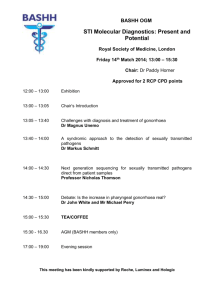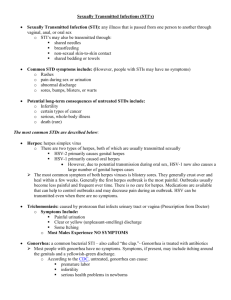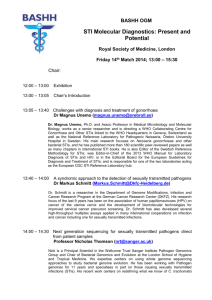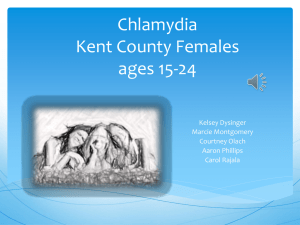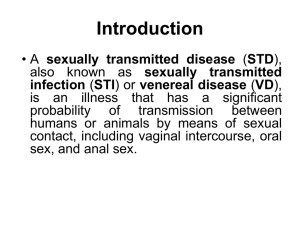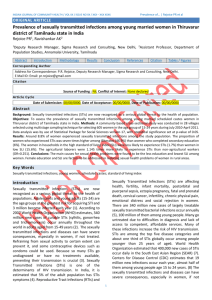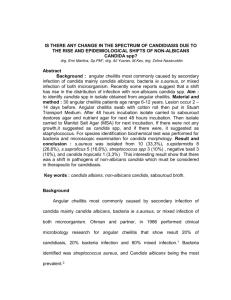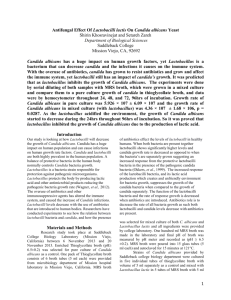focus on STI it_Layout 1
advertisement
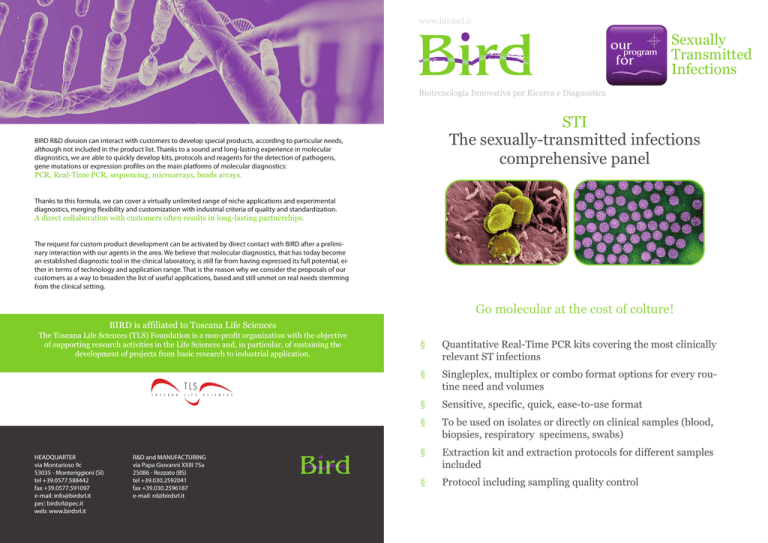
www.birdsrl.it our program for Sexually Transmitted Infections Biotecnologia Innovativa per Ricerca e Diagnostica STI The sexually-transmitted infections comprehensive panel BIRD R&D division can interact with customers to develop special products, according to particular needs, although not included in the product list. Thanks to a sound and long-lasting experience in molecular diagnostics, we are able to quickly develop kits, protocols and reagents for the detection of pathogens, gene mutations or expression profiles on the main platforms of molecular diagnostics: PCR, Real-Time PCR, sequencing, microarrays, beads arrays. Thanks to this formula, we can cover a virtually unlimited range of niche applications and experimental diagnostics, merging flexibility and customization with industrial criteria of quality and standardization. A direct collaboration with customers often results in long-lasting partnerships. The request for custom product development can be activated by direct contact with BIRD after a preliminary interaction with our agents in the area. We believe that molecular diagnostics, that has today become an established diagnostic tool in the clinical laboratory, is still far from having expressed its full potential, either in terms of technology and application range. That is the reason why we consider the proposals of our customers as a way to broaden the list of useful applications, based and still unmet on real needs stemming from the clinical setting. Go molecular at the cost of colture! BIRD is affiliated to Toscana Life Sciences The Toscana Life Sciences (TLS) Foundation is a non-profit organization with the objective of supporting research activities in the Life Sciences and, in particular, of sustaining the development of projects from basic research to industrial application. HEADQUARTER via Montarioso 9c 53035 - Monteriggioni (SI) tel +39.0577.588442 fax +39.0577.591097 e-mail: info@birdsrl.it pec: birdsrl@pec.it web: www.birdsrl.it R&D and MANUFACTURING via Papa Giovanni XXIII 75a 25086 - Rezzato (BS) tel +39.030.2592041 fax +39.030.2596187 e-mail: rd@birdsrl.it § Quantitative Real-Time PCR kits covering the most clinically relevant ST infections § Singleplex, multiplex or combo format options for every routine need and volumes § Sensitive, specific, quick, ease-to-use format § To be used on isolates or directly on clinical samples (blood, biopsies, respiratory specimens, swabs) § Extraction kit and extraction protocols for different samples included § Protocol including sampling quality control www.birdsrl.it SEXUALLY TRANSMITTED DISEASES: A GLOBAL BURDEN Biotecnologia Innovativa per Ricerca e Diagnostica Species Format Code Availability Chlamydia trachomatis, Neisseria gonorrhoeae, Trichomonas vaginalis - triplex Chlamydia trachomatis, Neisseria gonorrhoeae - duplex Trychomonas vaginalis Mycoplasma genitalium Mycoplasma hominis Ureaplasma urealyticum Ureaplasma parvum Mycoplasma multiplex 1(M.genitalium, M.hominis, U.urealyticum) Mycoplasma multiplex 2 (M.genitalium, T.vaginallis) Mycoplasma multiplex 3 (M.genitalium, U.urealyticum) Mycoplasma multiplex 4 (M.hominis, U.parvum) Gardenerella vaginalis STI combo Treponema pallidum HSV 1/2 25/50 25/50 25/50 25/50 25/50 25/50 25/50 25/50 25/50 25/50 25/50 25/50 20 25/50 25/50 B042.25/B042 B043.25/B043 P031.25/P031 B009.25/B009 B010.25/B010 B011.25/B011 B012.25/B012 B038.25/B038 B037.25/B037 B039.25/B039 B040.25/B040 B030.25/B030 B041 B028.25/B028 V015.25/V015 Available Available Available Available Available Available Coming soon Available Available On request On request Available On request On request On request Atopobium vaginae Lactobacillus spp Lactobacillus iners Lactobacillus crispatus 25/50 25/50 25/50 25/50 B031.25/B031 B032.25/B032 B033.25/B033 B034.25/B034 On request On request On request On request HPV 12 HR Screening – Quant HPV 14 HR Screening HPV 14 HR Typing – Quant HPV 12 HR Typing HPV 12 HR & 2 LR Typing 100 50 100 50 50 HPV01 HPV02 HPV03 HPV04 HPV05 Available Available Available Available Available Candida spp Candida albicans Candida glabrata Candida parapsilosis Candida tropicalis Candida krusei Candida multiplex 1 (C.spp, C.albicans) Candida multiplex 2 (C.glabrata, C.parapsilosis) Candida multiplex 3 (C.tropicalis, C.krusei) Candida Combo 25/50 25/50 25/50 25/50 25/50 25/50 25/50 25/50 25/50 20 M006.25/M006 M007.25/M007 M008.25/M008 M010.25/M010 M011.25/M011 M022.25/M022 M023.25/M023 M024.25/M024 M025.25/M025 M026 Available Available Available Available Available Coming soon Available Coming soon Coming soon On request Sexually transmitted infections (STI), also referred to as sexually transmitted diseases (STD) and venereal diseases (VD), are infections that are commonly spread by sex. Most STIs initially do not cause symptoms. This results in a greater risk of passing the disease on to others. STIs acquired before or during birth may result in poor outcomes for the baby. Some STIs may cause problems with the ability to get pregnant. More than 30 different bacteria, viruses, and parasites can cause STIs. Bacterial STIs include chlamydia, gonorrhea, and syphilis among others. Viral STIs include genital herpes HIV/AIDS, and genital warts among others. Parasitic STIs include trichomoniasis among others. While usually spread by sex, some STIs can also be spread by non-sexual contact with contaminated blood and tissues, breastfeeding, or during childbirth. STIs represent a sigInificant diseas burden globally. In 2008, it was estimated that 500 million people were infected with either syphilis, gonorrhea, chlamydia or trichomoniasis. At least an additional 530 million people have genital herpes and 290 million women have human papillomavirus. In the United States there were 19 million new cases of sexually transmitted infections in 2010. Chlamydia is a sexually transmitted infection caused by the bacterium Chlamydia trachomatis. In women, symptoms may include abnormal vaginal discharge, burning during urination, and bleeding in between periods, although most women do not experience any symptoms. Symptoms in men include pain when urinating, and abnormal discharge from their penis. If left untreated in both men and women, Chlamydia can infect the urinary tract and potentially lead to pelvic inflammatory disease (PID). PID can cause serious problems during pregnancy and even has the potential to cause infertility. It can cause a woman to have a potentially deadly ectopic pregnancy. The two most common forms of herpes are caused by infection with herpes simplex virus (HSV). HSV-1 is typically acquired orally and causes cold sores, HSV-2 is usually acquired during sexual contact and affects the genitals, however either strain may affect either site. Some people are asymptomatic or have very mild symptoms. Those that do experience symptoms usually notice them 2 to 20 days after exposure which last 2 to 4 weeks. Symptoms can include small fluid-filled blisters, headaches, backaches, itching or tingling sensations in the genital or anal area, pain during urination, Flu like symptoms, swollen glands, or fever. Molecular assays have become increasingly popular for screening and diagnosis of sexually transmitted infections. Chlamydia detection through molecular assays circumvents the drawbacks of microscopy conventional tests, which are subjective and lack sensitivity. The detection and typing of High Risk HPV types is now part of the routine screenig for the carcinoma of the cervix. Molecular diagnostics permits to differentiate distinct species of Mycoplasma, or the specific detection of Trichomonas vaginalis, thus helping in detecting and classifying non-gonococcal urethritis and other pathologies of the genitourinary tract. Also, an invaluable advantage of molecular assays is the possibility of multiplexing the assays, targeting different pathogens in the same reaction, saving costs and time in analyzing the most common pathogens causing sexually transmitted diseases.
